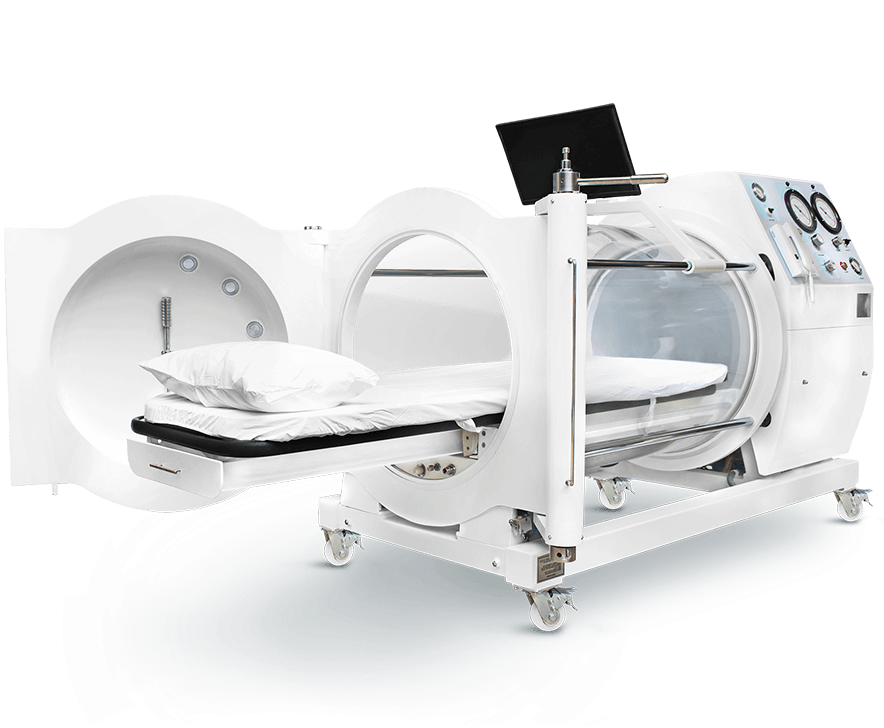Hyperbaric Oxygen Therapy (HBOT)
Hyperbaric Oxygen Therapy (HBOT) is a treatment that involves breathing 100% oxygen in a pressurized room or chamber. This treatment increases the amount of oxygen dissolved in the blood. Saturating organs and tissues with critical oxygen yields many health benefits. HBOT reduces inflammation and swelling while helping the body to fight infection. It also stimulates the release of substances called growth factors and stem cells that promote healing and cause formation of new blood vessels, bone and cartilage regeneration.
Dr. Otto Warburg, Nobel Prize winner in medicine (1931)
“The fundamental cause of all degenerative disease is a condition called Hypoxia, oxygen deprival at cellular level”
HBOT is a well-established treatment for many conditions. Research indicates that HBOT is helpful for a variety of conditions. Some of the current conditions treated with HBOT are as follows:
Conditions we Treat with HBOT
- Diabetic foot and leg ulcers/diabetic wounds classified as Wagner III or higher that have failed standard wound care
- Gas gangrene/Clostridium perfringens infection, as an adjunct to surgical treatment
- Progressing necrotizing soft tissue -as an adjunct to surgical treatment
- Actinomycosis, only as an adjunct to conventional therapy when the disease process is refractory to antibiotics and surgical treatment
- Vascular ulcers caused by poor circulation/Acute peripheral arterial insufficiency
- Acute traumatic peripheral ischemia
- Crush injuries and sutured severed limbs
- Preparation and preservation of compromised skin grafts
- Chronic refractory osteomyelitis, unresponsive to conventional medical and surgical management
- Osteoradionecrosis/Delayed radiation injuries, as an adjunct to conventional treatment
- Soft tissue radionecrosis/Radiation injuries, as an adjunct to conventional treatment
- Acute carbon monoxide poisoning
- Cyanide poisoning
- Gas/air bubbles in the bloodstream/Gas embolism
- Decompression illness/certain scuba diving injuries
- Sports Injury/Increase recovery of muscle, and bone/cartilage regeneration; as an adjunct to conventional medical treatment.
Emerging Hyperbaric Oxygen Therapy (HBOT) Treatments
Other emerging areas of Hyperbaric Oxygen Therapy (HBOT) application, supported by recent research (Sagol Center for Hyperbaric Oxygen Therapy and Research, Tel Aviv); and others (Case Rep Oncol 2020; 13:365-372), are as follows.
- Age-related Cognitive and functional Decline, as an adjunct to conventional medical therapy
- Post-Stroke recovery, as an adjunct to conventional medical therapy
- Post-concussion syndrome due to traumatic brain injury (TBI), as an adjunct to conventional medical treatment
- Post Traumatic Stress Disorder (PTSD)
- Sickle Cell Disease and aseptic osteonecrosis
For the above treatments, the medical staff of our clinic, Wound care, Hyperbaric Oxygen Therapy, and Vascular/Endovascular Clinic, will perform a series of assessments to determine if HBOT is suitable for each patient, depending on their specific case.
Physiological Effects of Hyperbaric Oxygen Therapy:
The Hyperbaric Oxygen Therapy produces strong hyperoxia that generates different benefits for the body.
- Repair of peripheral neuronal fibers
Oxygen promotes nervous system plasticity.
- Angiogenesis
Hyperoxia stimulates and promotes the formation of small blood vessels, thus improving perfusion.
- Collagen synthesis stimulation
Hyperoxia induces proline hydroxylation and fibroblast proliferation. Thus, it promotes collagen synthesis, which is essential for wound healing and tissue repair.
- Bactericidal activity
Hyperoxia generates reactive oxygen species that increase the activity of antibiotics. It is also active against bacterial biofilm (a protective film produced by bacteria).
- Regulation of oxidative stress and inflammatory response
Hyperoxia acts as regulators and mediators of the inflammatory response and decreases oxidative stress. This results in an anti-inflammatory effect and decreases cell damage.
- Increases cerebral blood flow and neuroprotection
It improves perfusion, thanks to the formation of new vessels and cerebral oxygenation, decreases edema and inflammation of the central nervous system.
- Osteogenesis
Hyperoxia stimulates the differentiation of bone-forming cells, promotes osteogenesis and bone repair.
- Decreases ischemic-reperfusion injury/damage
Hyperoxia improves tissue microcirculation, decreases the production of reactive oxygen species and increases their degradation by stimulating the expression of antioxidant enzymes.
- Analgesic effect
HBOT has an analgesic effect in nociceptive and neuropathic pain; through tissue repair, recovery of functionality and reduction of inflammation.

